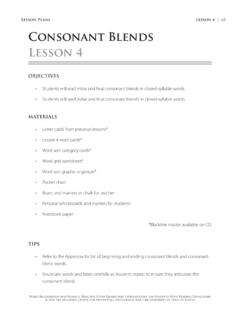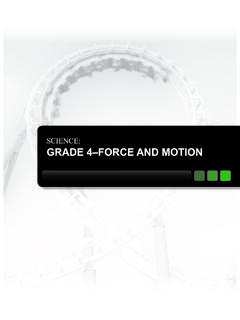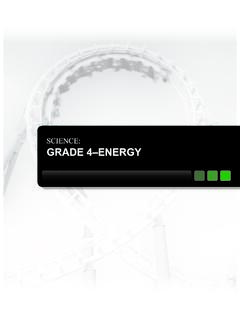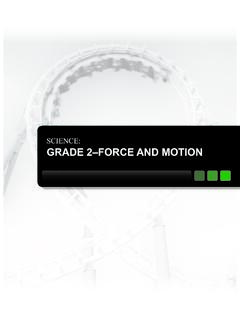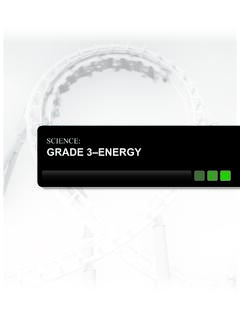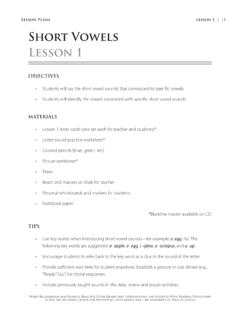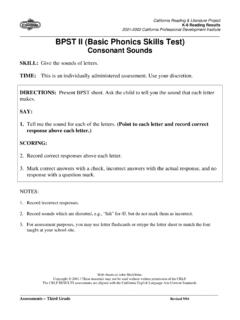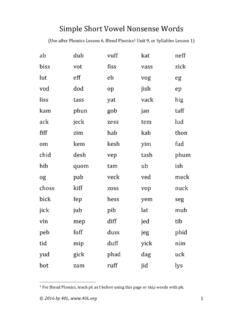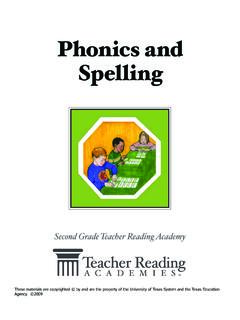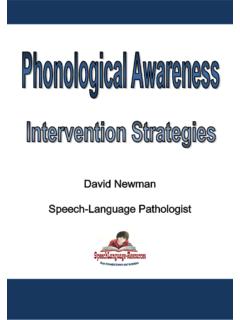Transcription of Vowel-Consonant-Silent e Multisyllabic Words
1 phonics PART 2 Lesson Plan: Vowel-Consonant-Silent e Multisyllabic Words OBJECTIVE: The student will learn how to read and write Words with the Vowel-Consonant-Silent e syllable pattern by dividing the word into syllables. MATERIALS: Chart to display: Word list for ADDITIONAL WORD READING PRACTICE: evoke milestone cupcake immune stampede complete unmade reptile erase locate inside trombone bathrobe inhale pancake inmate ozone update provoke lifetime headache skyline escape tightrope refuse TEACHER BACKGROUND INFORMATION: Many one- syllable Words contain the Vowel-Consonant-Silent e pattern, such as made, tape, dime, note, and tube.
2 In a one syllable word, when a word ends in the letter e and one vowel and one consonant comes before the e, the e is silent and the vowel has the long vowel sound. This pattern has been taught in grades 1 and 2, however, some students in grades 3-5 will need to be retaught and reminded through many exposures in a variety of settings. Once students have learned to recognize this pattern, it s easy for them to see the same pattern in Multisyllabic Words because the Vowel-Consonant-Silent e pattern usually occurs at the end of Multisyllabic Words , just as it occurs at the end of one- syllable Words . The Vowel-Consonant-Silent e pattern stays together as a syllable , and the other syllable division rules can be applied to the rest of the word to determine how the word is divided and then blended to pronounce the word.
3 Multi- syllable Words with silent e: 1. How many vowels in the word? (fingers) 2. Are the vowels together or apart? (hands) 3. Do you see a silent e? (thumbs up or down) 4. How many syllables are in the word? (fingers) 5. Draw lines to separate the syllables. 6. Read each syllable . blend to read a whole word. phonics PART 2 The chart in the materials section above provides a routine that students can easily respond to. The same chart is provided below with more details to support your teaching of the routine and the possible questions or confusions that may surface when teaching the Vowel-Consonant-Silent e pattern in Multisyllabic Words .
4 Multi- syllable Words with silent e: 1. How many vowels in the word? (Use fingers to show) 2. Are the vowels together or apart? (Use hands to show) (When vowels are together, they usually represent one vowel sound. vowel teams work together to make one syllable . Examples: pay, r aid, bead, feet, pie, boat, toe, snow, shout, foi l, repeat, chimpanzee, boomerang, poi sonous, continue) 3. Do you see a silent e? (Thumbs up or thumbs down) (The silent e connects to the closest vowel in the syllable . The VCe pattern indicates one syllable . Draw a circle around the VCe pattern in the word to show the connection.) 4. How many syllables are in the word?
5 (Use fingers to show) 5. Draw lines to separate the syllables. (Use previously learned syllable division rules*) 6. Read each syllable . blend to read a whole word. *Helpful syllable Division Rules: Divide syllables between two consonants that are the same. (but/ton) When two consonants are together, divide between the consonants. ( mag/net) Keep blends, digraphs, and r-controlled vowels together. ( con/stant; mush/room; car/ni v/al) Keep vowel teams together. (re/peat) Divide compound Words between the two smaller Words . (base/ball) Keep one- syllable prefixes and suffixes together. (-ed, -ing, un-, dis- re-) LESSON CYCLE: 1.
6 CONNECT TO PREVIOUS LEARNING: Review one syllable Words that have the Vowel-Consonant-Silent e pattern using these examples: mad made; hid hide; cut cute On a strip of paper or a shortened sentence strip, write the word made. Fold the right portion of the strip (the part that has the silent e) behind the word so that only the word mad is exposed. When you open the folded e, the students will see the word made. When you fold the right portion behind, the word mad will show on the strip. Show the sentence strip with the word mad (e folded behind.) Read this syllable . Is the syllable open or closed?
7 What is the vowel sound? Read the syllable again. Open the fold to expose the silent e at the end of mad (showing the word made.) Review the rule for Vowel-Consonant-Silent e Words . mad e hid e cut e phonics PART 2 When a word ends in the letter e and one vowel and one consonant come before the e, the e is silent and the vowel has the long vowel sound. Point to the word made. The word ends in the letter e and it has one vowel , a, and one consonant , d, before the e. With this pattern, the e is silent and the vowel has the long a sound. Read the syllable . Repeat the same sequence using the sentence strips for hid hide and cut cute.
8 2. TEACH/ MODEL: Dividing Two- syllable Words with the Vowel-Consonant-Silent e pattern: Today you re going to learn how to read two- syllable Words by dividing the word into syllables. The Words will contain the Vowel-Consonant-Silent e pattern. We can use the following steps to help us remember how to divide Words that contain the Vowel-Consonant-Silent e pattern: Display the above Steps to Read Multi- syllable Words with silent e. Use the word reptile to teach the steps. Write the word reptile on the board for all students to view. Do not say the word aloud. Step 1: How many vowels in the word? (fingers) First we ll locate and count the vowels.
9 I see 3 vowels in this word, the e, the i, and the final e. I ll use my fingers to show how many vowels I see. (Hold up 3 fingers.) Step 2: Are the vowels together or apart? (hands) The next step asks whether the vowels are together or apart. I see that in this word the vowels e, i and the last e are apart. I ll show this with my hands. (Hold up your hands and show an outward movement.) Step 3: Do you see a silent e? (thumbs up or down) Step 3 asks if we see a silent e. The word ends with a silent e so I ll show this with a thumbs up signal. ( Point to your brain and say), This makes me think, when a word ends in the letter e and one vowel and one consonant come before the e, the e is silent and the vowel has the long vowel sound.
10 The VCe pattern stays together as one syllable . (Draw a circle around the -ile at the end of reptile.) This says / l/. Steps to Read Multi- syllable Words with silent e: 1. How many vowels in the word? (fingers) 2. Are the vowels together or apart? (hands) 3. Do you see a silent e? (thumbs up or down) 4. How many syllables are in the word? (fingers) 5. Draw lines to separate the syllables. 6. Read each syllable . blend to read a whole word. phonics PART 2 Step 4: How many syllables are in the word? (fingers) Step 4 asks how many syllables are in the word. Remember that every syllable has only one vowel sound. When I count the vowel sounds, I know that the first e makes one syllable and the -ile will stay together as one syllable .

